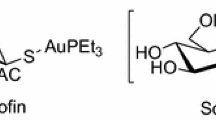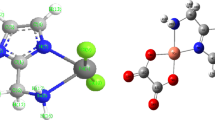Abstract
Novel lipophilic gold(I) complexes containing 1,3,4-oxadiazol-2-thione or 1,3-thiazolidine-2-thione derivatives were synthesized and characterized by IR, high resolution mass spectrometry, and 1H, 13C 31P NMR. The cytotoxicity of the compounds was evaluated considering cisplatin and/or auranofin as reference in different tumor cell lines: colon cancer (CT26WT), metastatic skin melanoma (B16F10), breast adenocarcinoma (MCF-7), cervical carcinoma (HeLa), glioblastoma (M059 J). Normal human lung fibroblasts (GM07492-A) and kidney normal cell (BHK-21) were also evaluated. The gold(I) complexes were more active than their respective free ligands and cisplatin. Furthermore, antibacterial activity was evaluated against Gram-positive bacteria Staphylococcus aureus ATCC 25213, Staphylococcus epidermidis ATCC 12228 and Gram-negative bacteria Escherichia coli ATCC 11229 and Pseudomonas aeruginosa ATCC 27853 and expressed as the minimum inhibitory concentration (MIC). The complexes exhibited lower MIC values when compared to the ligands and chloramphenicol against Gram-positive bacteria and Gram-negative bacteria. Escherichia coli was sensitive one to the action of gold(I) complexes.






Similar content being viewed by others
Change history
11 October 2017
This article has been corrected. One of the author names was given incorrect. Please find in this erratum the correct author name: “Heloiza Diniz Nicolella” that should be regarded as final by the reader.
Abbreviations
- IR:
-
Infrared
- NMR:
-
Nuclear magnetic resonance
- TMS:
-
Tetramethylsilane
- HEPES:
-
4-(2-Hydroxyethyl)piperazine-1-ethanesulfonic acid, N-(2-hydroxyethyl)piperazine-N′-(2-ethanesulfonic acid)
- HMRS (ESI):
-
High-resolution mass spectra (eletrospray ionization)
- FBS:
-
Fetal bovine serum
- MTT:
-
Methylthiazolyldiphenyl-tetrazolium bromide
- HAM-F10:
-
Nutrient mixture F-10
- DMEM:
-
Dulbecco’s Modified Eagle’s Medium
- XTT:
-
2,3-Bis(2-methoxy-4-nitro-5-sulfophenyl)-2H-tetrazolium-5-carboxanilide
- DMSO:
-
Dimethylsulfoxide
- PBS:
-
Phosphate buffer saline
- RPMI 1640:
-
Roswell Park Memorial Institute 1640 medium
- TTC:
-
2,3,5-Triphenyltetrazolium chloride
References
Baenziger NC, Bennett WE, Soborofe DM (1976) Chloro(triphenylphosphine)gold(I). Acta Crystallogr Sect B 32:962–963
Bakhtiar R, Ochiai E-I (1999) Pharmacological applications of inorganic complexes. Gen Pharmacol 32:525–540
Benedek TG (2004) The history of gold therapy for tuberculosis. J Hist Med Allied Sci 59:50–89
Chaves JDS, Neumann F, Francisco TM, Correa CC, Lopes MTP, Silva H, Fontes APS, de Almeida MV (2014) Synthesis and cytotoxic activity of gold(I) complexes containing phosphines and 3-benzyl-1,3-thiazolidine-2-thione or 5-phenyl-1,3,4-oxadiazole-2-thione as ligands. Inorg Chim Acta 414:85–90
Chaves JDS, Damasceno JL, Paula MCF, de OliveiraPF Azevedo GC, Matos RC, Lourenço MCS, Tavares DC, Silva H, Fontes APS, de Almeida MV (2015) Synthesis, characterization, cytotoxic and antitubercular activities of new gold(I) and gold(III) complexes containing ligands derived from carbohydrates. Biometals 28:845–860
Chaves JDS, Tunes LG, Franco CHJ, FranciscoTM Correa CC, Murta SMF, Monte-Neto RL, Silva H, Fontes APS, de Almeida MV (2017) Novel gold(I) complexes with 5-phenyl-1,3,4-oxadiazole-2-thione and phosphine as potential anticancer and antileishmanial agents. Eur J Med Chem 127:727–739
Clinical and Laboratory Standards Institute (CLSI) (2015) Methods for dilution antimicrobial susceptibility tests for bacteria that grow aerobically (M07-A10), 10th edn. CLSI, Wayne
Coimbra ES, de Almeida MV, Junior CO, Taveira AF, da Costa CF, de Almeida AC, Reis EF, da Silva AD (2010) Synthesis and antileishmanial activity of lipidic amino alcohols. Chem Biol Drug Des 75:233–235
de Almeida AM, Nascimento T, Ferreira BS, de Castro PP, Silva VL, Diniz CG, Le Hyaric M (2013) Synthesis and antimicrobial activity of novel amphiphilic aromatic amino alcohols. Bioorg Med Chem Lett 23:2883–2887
de Souza SM, Delle Monache F, Smania A Jr (2005) Antibacterial activity of coumarins. Z Nat C 60:693–700
Ferreira BDS, de Almeida AM, Nascimento TC, de Castro PP, Silva VL, Diniz CG, Le Hyaric M (2014) Synthesis and biological evaluation of a new series of N-acyldiamines as potential antibacterial and antifungal agents. Bioorg Med Chem Lett 24:4626–4629
Garcia A, Machado RC, Grazul RM, Lopes MTP, Correa CC, dos Santos HF, de Almeida MV, Silva H (2016) Novel antitumor adamantane-azole gold(I) complexes as potential inhibitors of thioredoxin reductase. JBIC J Biol Inorg Chem 21:275–292
Lucas SJ, Lord RM, Basri AM, Allison SJ, Phillips RM, Blacker AJ, McGowan PC (2016) Increasing anti-cancer activity with longer tether lengths of group 9 Cp* complexes. Dalton Trans 45:6812–6815
Manjunatha K, Poojary B, Lobo PL, Fernandes J, Kumari NS (2010) Synthesis and biological evaluation of some 1,3,4-oxadiazole derivatives. Eur J Med Chem 45:5225–5233
Medici S, Peana M, Nurchi VM, Lachowicz JI, Crisponi G, Zoroddu MA (2015) Noble metals in medicine: latest advances. Coord Chem Rev 284:329–350
Mirabelli CK, Johnson RK, Sung CM, Faucette L, Muirhead K, Crooke ST (1985) Evaluation of the in vivo antitumor activity and in vitro cytotoxic properties of auranofin, a coordinated gold compound, in murine tumor models. Cancer Res 45:32–39
Ott I (2009) On the medicinal chemistry of gold complexes as anticancer drugs. Coord Chem Rev 253:1670–1681
Reis EFC, Júnior COR, Alves LL, Ferreira AP, De Almeida MV (2008) Synthesis and immunosuppressive activity of lipophilic amino alcohols and diamines. Chem Biol Drug Des 72:596–598
Rosenberg B, Vancamp L, Trosko JE, Mansour VH (1969) Platinum compounds: a new class of potent antitumour agents. Nature 222:385–386
Shi J-C, Chen L-J, Huang X-Y, Wu D-X, Kang B-S (1997) Chiral phosphine ligands derived from sugars 10. Syntheses, structure, characterization, and antitumor activity of the gold(I) complexes with sugar-substructure phosphine ligands. J Organomet Chem 535:17–23
Thangamani S, Mohammad H, Abushahba MFN, Sobreira TJP, Hedrick VE, Paul LN, Seleem MN (2016) Antibacterial activity and mechanism of action of auranofin against multi-drug resistant bacterial pathogens. Sci Rep 6:22571
Acknowledgements
The authors wish to thank CAPES, CNPq and FAPEMIG for financial supports and fellowships. This work is a collaboration research project of members of the Rede Mineira de Química (RQ-MG) supported by FAPEMIG (Project: CEX- RED-0010/14).
Author information
Authors and Affiliations
Corresponding author
Additional information
This article has been corrected. One of the author names was given incorrect. The corrected author name is: “Heloiza Diniz Nicolella” and should be regarded as final by the reader.
A correction to this article is available online at https://doi.org/10.1007/s10534-017-0049-3.
Rights and permissions
About this article
Cite this article
de Almeida, A.M., de Oliveira, B.A., de Castro, P.P. et al. Lipophilic gold(I) complexes with 1,3,4-oxadiazol-2-thione or 1,3-thiazolidine-2-thione moieties: synthesis and their cytotoxic and antimicrobial activities. Biometals 30, 841–857 (2017). https://doi.org/10.1007/s10534-017-0046-6
Received:
Accepted:
Published:
Issue Date:
DOI: https://doi.org/10.1007/s10534-017-0046-6




